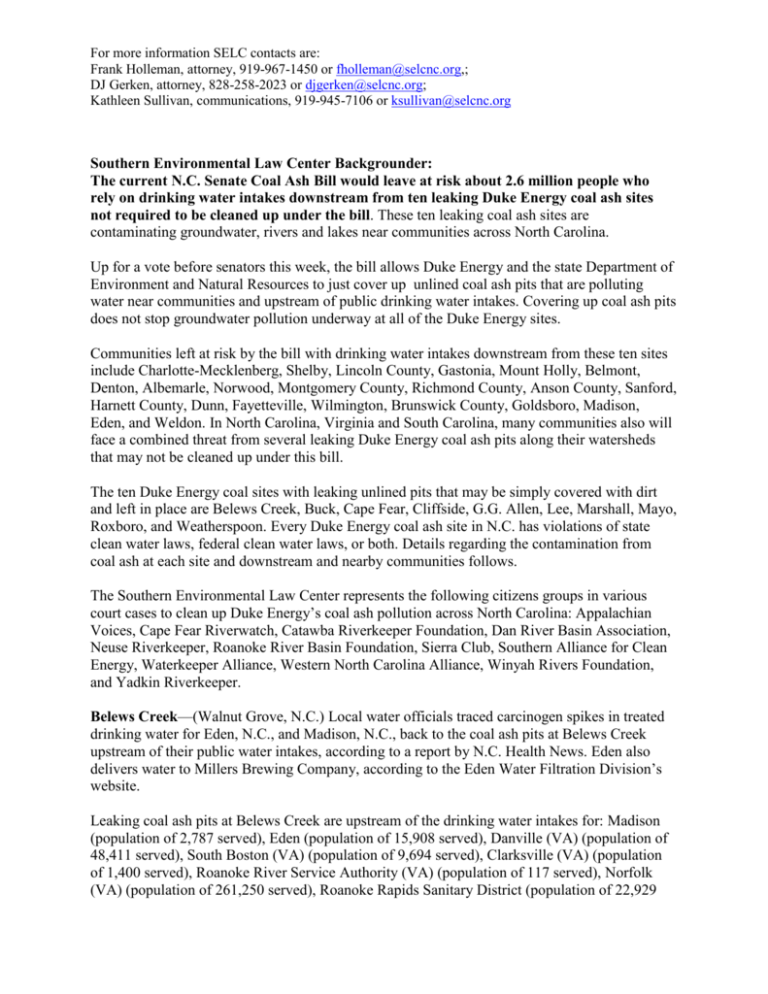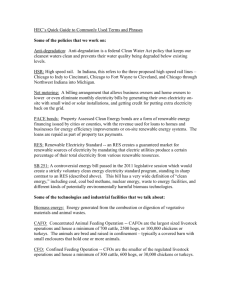6-25-14-Dirty-Ten-sites-final
advertisement

For more information SELC contacts are: Frank Holleman, attorney, 919-967-1450 or fholleman@selcnc.org,; DJ Gerken, attorney, 828-258-2023 or djgerken@selcnc.org; Kathleen Sullivan, communications, 919-945-7106 or ksullivan@selcnc.org Southern Environmental Law Center Backgrounder: The current N.C. Senate Coal Ash Bill would leave at risk about 2.6 million people who rely on drinking water intakes downstream from ten leaking Duke Energy coal ash sites not required to be cleaned up under the bill. These ten leaking coal ash sites are contaminating groundwater, rivers and lakes near communities across North Carolina. Up for a vote before senators this week, the bill allows Duke Energy and the state Department of Environment and Natural Resources to just cover up unlined coal ash pits that are polluting water near communities and upstream of public drinking water intakes. Covering up coal ash pits does not stop groundwater pollution underway at all of the Duke Energy sites. Communities left at risk by the bill with drinking water intakes downstream from these ten sites include Charlotte-Mecklenberg, Shelby, Lincoln County, Gastonia, Mount Holly, Belmont, Denton, Albemarle, Norwood, Montgomery County, Richmond County, Anson County, Sanford, Harnett County, Dunn, Fayetteville, Wilmington, Brunswick County, Goldsboro, Madison, Eden, and Weldon. In North Carolina, Virginia and South Carolina, many communities also will face a combined threat from several leaking Duke Energy coal ash pits along their watersheds that may not be cleaned up under this bill. The ten Duke Energy coal sites with leaking unlined pits that may be simply covered with dirt and left in place are Belews Creek, Buck, Cape Fear, Cliffside, G.G. Allen, Lee, Marshall, Mayo, Roxboro, and Weatherspoon. Every Duke Energy coal ash site in N.C. has violations of state clean water laws, federal clean water laws, or both. Details regarding the contamination from coal ash at each site and downstream and nearby communities follows. The Southern Environmental Law Center represents the following citizens groups in various court cases to clean up Duke Energy’s coal ash pollution across North Carolina: Appalachian Voices, Cape Fear Riverwatch, Catawba Riverkeeper Foundation, Dan River Basin Association, Neuse Riverkeeper, Roanoke River Basin Foundation, Sierra Club, Southern Alliance for Clean Energy, Waterkeeper Alliance, Western North Carolina Alliance, Winyah Rivers Foundation, and Yadkin Riverkeeper. Belews Creek—(Walnut Grove, N.C.) Local water officials traced carcinogen spikes in treated drinking water for Eden, N.C., and Madison, N.C., back to the coal ash pits at Belews Creek upstream of their public water intakes, according to a report by N.C. Health News. Eden also delivers water to Millers Brewing Company, according to the Eden Water Filtration Division’s website. Leaking coal ash pits at Belews Creek are upstream of the drinking water intakes for: Madison (population of 2,787 served), Eden (population of 15,908 served), Danville (VA) (population of 48,411 served), South Boston (VA) (population of 9,694 served), Clarksville (VA) (population of 1,400 served), Roanoke River Service Authority (VA) (population of 117 served), Norfolk (VA) (population of 261,250 served), Roanoke Rapids Sanitary District (population of 22,929 served), and Weldon Water System (population of 1,375 served). About 363,871 people rely on drinking water intakes downstream from Belews Creek coal ash pits. Coal ash pits at Belews Creek discharge directly into West Belews Creek/Belews Lake and the Dan River. Groundwater contamination from coal ash at Belews Creek* includes: -Chromium (Highest exceedance 50% above standard)(Cancer, ulcers and other stomach problems) -Iron (Highest exceedance 4,600% above standard)(Renders water unusable: rusty color, metallic taste, sedimentation, and staining) -Manganese (Highest exceedance 7,100% above standard)(Nervous system, muscle problems, mental problems) Buck—(Salisbury, N.C.) Leaking coal ash pits at Buck are upstream of the drinking water intakes for: Denton (population of 3,080 served), Albemarle (population of 16,042 served), Norwood (population of 3,944 served), Montgomery County Water System (population of 14,250 served), Anson County (population of 12,625 served), Richmond County (population of 18,275 served), Chesterfield (SC) (population of 6,990 served), Florence (SC) (population of 70,476 served), Georgetown (SC) (population of 10,060 served), and Horry (SC) (population of 137,955 served). About 293,697 people rely on drinking water intakes downstream from Buck coal ash pits. The Buck coal ash pits are also located directly upstream of High Rock Lake, a popular recreational area for fishing, swimming, and boating. The state recently cited Duke for broken, failing corrugated metal stormwater pipes at Buck that are cracked and leaking, the same problem that caused the Dan River coal ash spill in February. Coal ash pits at the Buck facility are discharging through numerous unpermitted flows, seeps, leaks, and channels, including engineered discharges from the coal ash pits into the Yadkin River. Groundwater contamination from coal ash at Buck Steam Station* includes: Boron (Highest exceedance 84% above standard)(Reproductive problems, gastrointestinal illness) -Chromium (Highest exceedance 180% above standard)(Cancer, ulcers and other stomach problems) -Iron (Highest exceedance 567% above standard)(Renders water unusable: rusty color, metallic taste, sedimentation, and staining) -Manganese (Highest exceedance 2,160% above standard)(Nervous system, muscle problems, mental problems) -Sulfates (Highest exceedance 40% above standard)(Gastrointestinal problems) -Total Dissolved Solids (Highest exceedance 20% above standard)(Makes drinking water unpalatable, can cause scale buildup in pipes, valves, and filters) Because the coal ash pits will likely cause loss of life in the event of failure, EPA rates the lagoons as significant hazards. Cape Fear—(Moncure, N.C.) Leaking coal ash pits at Cape Fear are upstream of the drinking water intakes for: Sanford (population of 43,650 served), Harnett County (population of 79,058 served), Dunn (population of 10,143 served), Fayetteville (population of 179,000 served), Wilmington (population of 132,936 served), and Brunswick County population of 76,212 served). About 520,999 people rely on drinking water intakes downstream from Cape Fear coal ash pits. Cape Fear is rated High Hazard and in Poor Condition by the Environmental Protection Agency. The dam at Cape Fear recently cracked. Recently, Duke Energy was caught pumping 61 million gallons of contaminated coal ash wastewater from the Cape Fear site. This intentional, illegal discharge was twice the amount spilled at Dan River. Groundwater contamination from coal ash at the Cape Fear Power Station* includes: -Antimony (Highest exceedance 70% above standard)(Eye irritation, heart damage, lung problems) -Boron (Highest exceedance 321% above standard) )(Reproductive problems, gastrointestinal illness) -Iron (Highest exceedance 18,100% above standard) (Renders water unusable: rusty color, metallic taste, sedimentation, and staining) -Manganese (Highest exceedance 35,900% above standard)(Nervous system, muscle problems, mental problems) -pH (Highest exceedance 17% above standard)(Highly damaging to fish and invertebrate life) -Selenium (Highest exceedance 106% above standard)(Birth defects, nervous system/reproductive problems) -Sulfates (Highest exceedance 152% above standard)(Gastrointestinal problems) -Total Dissolved Solids (Highest exceedance 120% above standard) (Makes drinking water unpalatable, can cause scale buildup in pipes, valves, and filters) Cliffside—(Shelby, N.C.) Leaking coal ash pits at Cliffside are upstream of the drinking water intake for Shelby (population of 21,263 served), Cherokee (SC) (population of 22,051 served), Union (SC) (population of 12,186 served), Lexington (SC) (population of 28,253 served), and Richland (SC) (population of 285,774 served). About 369,527 people rely on drinking water intakes downstream from Cliffside coal ash pits. Stormwater pipes beneath the Cliffside coal ash pits are cracked and leaking according to the state. Water quality sampling of unpermitted seeps by the Western North Carolina Alliance show arsenic over 27 times higher than the federal drinking water standard seeping from a coal ash pit into the Broad River, even though the pit has been dewatered and covered with soil – showing that this method of “closure” allowed by the current legislative bill does not protect families or our waterways from coal ash risks.. Coal ash pits at the Cliffside facility discharge through numerous unpermitted flows, seeps, leaks, and channels, including engineered discharges from the toe-drains of its ash settling basin, into the Broad River. Groundwater contamination from coal ash at Cliffside* includes: -Chromium (Highest exceedance 350% above standard) (Cancer, ulcers and other stomach problems) -Iron (Highest exceedance 3,197% above standard) (Renders water unusable: rusty color, metallic taste, sedimentation, and staining) -Manganese (Highest exceedance 1,400% above standard)(Nervous system, muscle problems, mental problems) -pH (Highest exceedance 28% above standard)(Highly damaging to fish and invertebrate life) -Sulfates (Highest exceedance 68% above standard) (Gastrointestinal problems) -Total Dissolved Solids (Highest exceedance 64% above standard) (Makes drinking water unpalatable, can cause scale buildup in pipes, valves, and filters) G.G. Allen—(Belmont, N.C.) Leaking coal ash pits at G.G. Allen are upstream of drinking water intakes for York (SC) (population of 66,396 served), Lancaster (SC) (population of 100,025 served), Chester (SC) (population of 14,022 served) and Kershaw (SC) (population of 18,057 and 15,554 served). About 114,054 people rely on drinking water intakes downstream from G.G. Allen coal ash pits. Coal ash pits at the G.G. Allen facility are also discharging through unpermitted flows, seeps, leaks, and channels, including engineered discharges, into the Catawba River. The state has uncovered cracked pipes with holes in them beneath the ash pond dams. The Allen plant has a history of structural deficiencies including releases of up to 20,000 gallons of ash sluice water directly into the Catawba River near Charlotte-Mecklenberg suburbs. Groundwater contamination from coal ash at G.G. Allen* includes: -Iron (Highest exceedance 2,683% above standard) (Renders water unusable: rusty color, metallic taste, sedimentation, and staining) -Manganese (Highest exceedance 1,790% above standard) (Nervous system, muscle problems, mental problems) -Nickel (Highest exceedance 444% above standard) (Cancer, lung problems, allergic reactions) pH (Highest exceedance 26% above standard) (Highly damaging to fish and invertebrate life) Lee—(Goldsboro, N.C.) Leaking coal ash pits at the Lee Power Station are upstream of drinking water intakes for Goldsboro (population of 34,415 served) and Neuse Regional Water & Sewer Authority (population of 93,238 served). About 127,653 people rely on drinking water intakes downstream from Lee coal ash pits. Groundwater contamination from coal ash at the Lee Power Station* includes: -Arsenic (Highest exceedance 6,550% above standard)(Multiple types of cancer) -Boron (Highest exceedance 606% above standard) )(Reproductive problems, gastrointestinal illness) -Chromium (Highest exceedance 403% above standard)(Cancer, ulcers and other stomach problems) -Iron (Highest exceedance 11,100% above standard) (Renders water unusable: rusty color, metallic taste, sedimentation, and staining) -Manganese (Highest exceedance 6,060% above standard)(Nervous system, muscle problems, mental problems) Total Dissolved Solids (Highest exceedance 280% above standard) )(Makes drinking water unpalatable, can cause scale buildup in pipes, valves, and filters) Marshall—(Terrell, N.C.) The sprawling coal ash pits at Marshall are upstream of drinking water intakes for Lincoln County (population of 24, 038 served), Charlotte-Mecklenburg (population of 774,331 served), Gastonia (population of 76,750 served), Belmont (population of 9,153 served), York (SC) (population of 66,396 served), Lancaster (SC) (populations of 25 served), Chester (SC) (population of 14,022 served) and Kershaw (SC) (population of 18,057 and 15,554 served). About 998,326 people rely on drinking water intakes downstream from Marshall coal ash pits. Multiple additional landfills are constructed on top of or adjacent to the active ash pit, including an “asbestos landfill.” Coal ash pits at Marshall discharge into Lake Norman, a popular lake with swimmers, boaters and fishers. Groundwater contamination from coal ash at Marshall* include: -Boron (Highest exceedance 547% above standard)(Reproductive problems, gastrointestinal illness) -Iron (Highest exceedance 237% above standard) (Renders water unusable: rusty color, metallic taste, sedimentation, and staining) -Manganese (Highest exceedance 284% above standard)(Nervous system, muscle problems, mental problems) -pH (Highest exceedance 20% above standard) (Highly damaging to fish and invertebrate life) -Sulfates (Highest exceedance 60% above standard) (Gastrointestinal problems) -Total Dissolved Solids (Highest exceedance 30% above standard) (Makes drinking water unpalatable, can cause scale buildup in pipes, valves, and filters) Mayo—(Roxboro, N.C.) Leaking coal ash pits at Mayo are upstream of drinking water intakes for Clarksville (VA) (population of 1,400 served), Roanoke River Service Authority (VA) (population of 117 served), Norfolk (VA) (population of 261,250 served), Roanoke Rapids (population of 22,929 served), and Weldon (population of 1,375 served). About 287,071 people rely on drinking water intakes downstream from Mayo coal ash pits. Coal ash pits at Mayo Steam Electric Plant have two permitted outfalls and eight stormwater outlets discharging directly into the Mayo Reservoir. Groundwater contamination from coal ash at Mayo Steam Station* includes: -Chromium (Highest exceedance 301% above standard)(Cancer, ulcers and other stomach problems) -Iron (Highest exceedance 787% above standard) (Renders water unusable: rusty color, metallic taste, sedimentation, and staining) -Manganese (Highest exceedance 2,7820% above standard)(Nervous system, muscle problems, mental problems) Roxboro—(Semora, N.C.) Leaking coal ash pits at Roxboro are upstream of drinking water intakes for Clarksville (VA) (population of 1,400 served), Roanoke River Service Authority (VA) (population of 117 served), Norfolk (VA) (population of 261,250 served), Roanoke Rapids (population of 22,929 served), and Weldon (population of 1,375 served). About 287,071 people rely on drinking water intakes downstream from Roxboro coal ash pits. Coal ash pits at Roxboro Power Station have seven permitted outfalls, with two outfalls discharging directly into Hyco Lake. Groundwater contamination from coal ash at Roxboro Power Station* includes: -Chromium (Highest exceedance 327% above standard)(Cancer, ulcers and other stomach problems) -Iron (Highest exceedance 663% above standard)(Renders water unusable: rusty color, metallic taste, sedimentation, and staining) -Manganese (Highest exceedance 732% above standard)(Nervous system, muscle problems, mental problems) -Sulfates (Highest exceedance 249% above standard)(Gastrointestinal problems) -Total Dissolved Solids (Highest exceedance 202% above standard)(Makes drinking water unpalatable, can cause scale buildup in pipes, valves, and filters) Weatherspoon—(Lumberton, N.C.) Leaking coal ash pits at Weatherspoon are upstream of drinking water intakes for Horry County (SC) (population of 137,955 served). A pipe under the Weatherspoon coal ash dam has “numerous gushers” from cracks in the pipe. The Weatherspoon coal ash pits are located along the Lumber River, which is designated as a one of North Carolina’s Natural and Scenic Rivers, as well as a National Wild and Scenic River. DENR recently issued a notice of deficiency for the Weatherspoon dams, which identifies “numerous gushers” at the coal ash pit, recognizes the problem as “serious,” and admits that “significant environmental damage” could occur in the event of dam failure. Groundwater contamination from coal ash at Weatherspoon* includes: -Iron (Highest exceedance 1,280% above standard) (Renders water unusable: rusty color, metallic taste, sedimentation, and staining) -Manganese (Highest exceedance 7% above standard)( Nervous system, muscle problems, mental problems) -Thallium (Highest exceedance 230% above standard)(Developmental defects) *groundwater monitoring data sourced from the North Carolina Department of Natural Resources (NCDENR)








